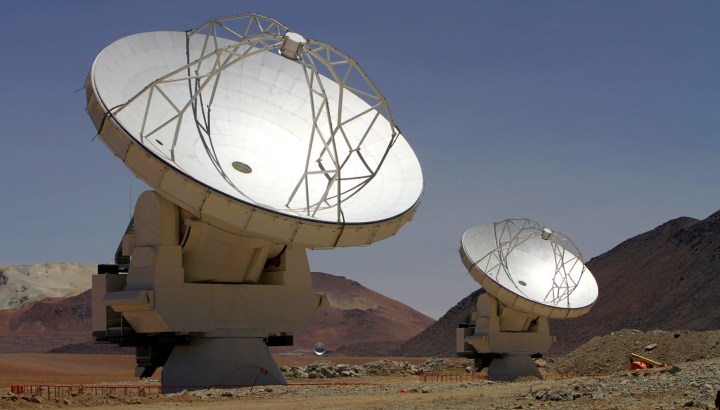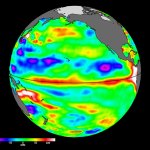Newsdeck
Decision time for SKA

The location of a huge radio telescope strong enough to detect extraterrestrial life in the far reaches of the universe could be settled on Friday when the group in charge of the project meets in the Netherlands. By Chris Wickham
When completed in 2024 the “Square Kilometre Array” (SKA) will be made up of 3,000 dishes, each 15 metres wide, together with many more antennae, that will stretch over 3,000 km (1,864 miles).
Scanning the sky 10,000 times faster and with 50 times the sensitivity of any other telescope, it will be used to study the origins of the universe and will be able to detect weak signals that could indicate the presence of extraterrestrial life.
A joint bid between Australia and New Zealand to host the telescope is pitted against South Africa for a $2 billion project that will bestow an economic boost and major scientific prestige on the winner.
The lobbying has been intense and at times acrimonious, with the Australians raising concerns about the security of such an expensive project in South Africa, which suffers from high rates of violent crime. South Africa has accused the other side of dirty tricks and selectively leaking data to boost its bid in what are supposed to be secret deliberations.
The project could now be split between the two bidders. In March, a science panel gave a marginal preference to South Africa but after intense lobbying from both bidders the decision was delayed and a group of experts was set up to examine the scientific and cost implications of a split location.
That group will report back to the consortium on Friday but scientists say a split location would almost certainly add to the bill.
Radio telescopes work best in remote locations away from interference from other radio signals, hence the decision to site this one in the more sparsely-populated southern hemisphere.
MORE THAN SCIENTIFIC EYE CANDY
The SKA is more than just a scientific bauble for the winner. Global tech companies are already earmarking development funds linked to the project, which will rely on computing technology that does not even exist yet to process the flood of data it will collect. Scientists estimate that the SKA will need processing power equivalent to several million of today’s fastest computers.
IBM and Astron, the Netherlands institute for radio astronomy, announced in April a 33 million euro ($42 million), five-year deal to develop extremely fast computer systems with low power requirements for the SKA project.
“If you take the current global daily Internet traffic and multiply it by two, you are in the range of the data set that the Square Kilometre Array radio telescope will be collecting every day,” said IBM Researcher Ton Engbersen at the announcement of the deal.
Other companies that have signed partnership agreements with the project include Nokia-Siemens, BAE Systems PLC, Cisco Systems Inc and Selex Galileo, a UK unit of Italian group Finmeccanica SpA.
The engineering and computing challenges are significant, not least the provision of power to run the array and the supercomputers in such a remote location.
It is in overcoming those challenges that the leaders of the project argue could lead to untold spin-offs for industry. They point to Wi-Fi technology as one of the best known commercial applications to come from radio astronomy, for instance.
The first phase of construction is set to start in 2016, and by 2019 about 10 percent of the array should be built, extending some 100 km from the telescope’s core. Expansion to 3,000 km should be complete by 2023 and the project will be fully up and running the following year.
ANSWERS TO BIG QUESTIONS
In an interview with Reuters, the leaders of the project said they hope the array will help to answer some of the biggest questions about the formation and make-up of the universe.
“For me, one of the most exciting questions is what is the universe made of,” said John Womersley, Chair of the Board of Directors of the SKA organisation. “We know that 5 pct of universe is made of atoms but what about the dark matter and other stuff that makes up 95 pct of the universe?
“Connecting to discoveries from the Large Hadron Collider, we will get a consistent picture of what the universe is made of.”
The Large Hadron Collider is the world’s largest and highest-energy particle accelerator and is testing some of the most basic theories in physics by smashing particle beams together to simulate the conditions in the universe a fraction of a second after the Big Bang.
Michiel van Haarlem, Director General of the group, said the telescope’s capabilities will expand over time.
“In stage one, finding out about the first stars and galaxies that formed in the universe, pulsars and gravitational radiation. Then in the second stage the role of magnetic fields in the formation of galaxies and looking for SETI (Search for Extraterrestrial Life) type things.”
The Britain-based consortium behind the telescope includes Canada, China, Germany, Italy, the Netherlands, the United Kingdom as well as Australia and South Africa. DM
Photo: A view of parabolic antennas of the ALMA (Atacama Large Millimetre/Submillimetre Array) project at the El Llano de Chajnantor in the Atacama desert, some 1730 km (1074 miles) north of Santiago and 5000 metres above sea level, February 11, 2010. REUTERS/Victor Ruiz Caballero.


















 Become an Insider
Become an Insider